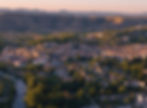joyeuse (07260)
GPS: 44.4713929, 04.2148386

Aerial view of Joyeuse

The tower in the castle at Joyeuse

Aerial view of Joyeuse
The medieval village of Joyeuse is located between two rivers, the Baume and the Drobie. It was an old silk capital, with silkworms, grindings and old stalls which revive each year in October during its traditional gourmet fair.
Joyeuse is a town of history and culture. Known as the city of Charlemagne, who fought there, Joyeuse owes its name, if one believes the legend, to its famous sword. During the summer there are plenty of organised tours through the old town that bring some of the history and legend to life. Another feature of this Ardèche village, is the chestnut museum.
There is much to see and enjoy in Joyeuse throughout the year. During a week at the beginning of August, the Festival de la Joye re-enacts some of the past through street shows with historical overtones, a parade of a hundred extras in costume and numerous theatrical troupes. Capital of the former duchy of Joyeuse, the old town attests to a very rich historical past, with the 16th century castle of the Dukes of Joyeuse and its Recluse Tower, the remains of the ramparts and its Sainte Anne and Jales gates , as well as St Pierre church which is the old ducal chapel. The chestnut museum tells the story of the breadfruit tree which can live a thousand years, and of its fruit which has nourished many generations. The Ardèche chestnut was granted AOC status in 2006 and is the Ardèche is the largest chestnut producing department in France. The market on Wednesday morning is one of the largest in the area and is very lively.
The legend of Charlemagne’s sword, La Joyeuse
The sword of Joyeuse, which today sits in the Louvre Museum, is one of the most famous swords in history. Historical records link the sword to Charlemagne the Great, King of the Franks. If it did indeed belong to the famous king, who reigned some 1,200 years ago, the sword of Joyeuse would have been used in countless coronation ceremonies and is tied with ancient myth and legend ascribing it with magical powers. The story begins in the year 802 AD. Legend states that the sword of Joyeuse was forged by the famous blacksmith Galas and took three years to complete. The sword was described as having magical powers associated with it. It was said to have been so bright that it could outshine the sun and blind its wielder's enemies in battle, and any person who wielded the legendary sword could not be poisoned. The Emperor Charlemagne, coming back from Spain was said to have set up camp in the region and acquired the sword. Charlemagne (742-814 AD), who was also known as Charles the Great, was king of the Franks and Christian emperor of the West. He did much to define the shape and character of medieval Europe and presided over the Carolingian Renaissance. After the fall of the Roman Empire, he was the first to reunite Western Europe. He ruled a vast kingdom that encompassed what is now France, Germany, Italy, Austria, and the Low Countries, consolidating Christianity through his vast empire through forced conversions. His military ‘accomplishments’ frequently involved extreme brutality, such as the beheading of more than 2,500 Frankish and Saxon village chiefs. One day, during battle, Charlemagne allegedly lost Joyeuse, and promised a reward for anyone who could find it. After several attempts, one of his soldiers brought it to him and Charlemagne kept his promise by saying, “Here will be built an estate of which you will be the lord and master, and your descendants will take the name of my wonderful sword: Joyeuse.” Charlemagne is said to have planted his sword in the ground to mark the point where the town would be built. According to the story, this is the origin of the French town of Joyeuse in Ardèche, which was founded on that spot and named in honour of the sword.
Market
Wednesday mornings: Place de la Grande Font. One of the most famous and lively markets in the Ardèche with elements of Provencal colours and scents, plenty of local producers, artisans and many other traders.




